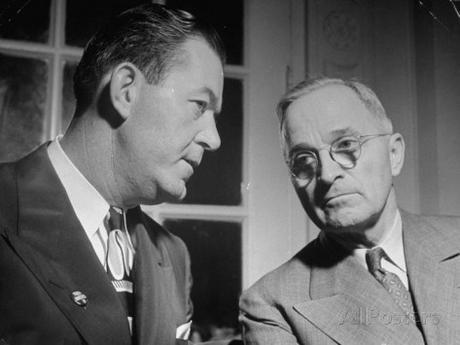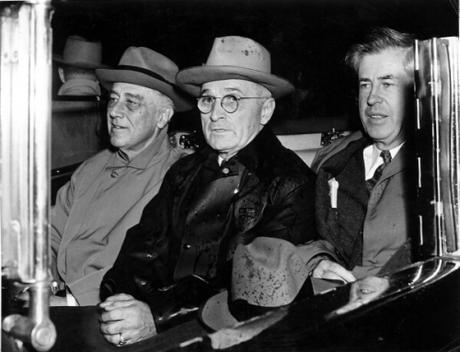Nominay is a regular commenter on this site. He also has his own blog called Endangered Left, and I must say, it is actually quite good. I was surprised when I first read it because I did not expect it to be as good as it is.
This piece originally appeared on his site. It is excellent. Ought to be read by anyone interested in US politics, especially US Left/liberal politics.
Understanding the Mechanics of Fate: How History Was Almost Different and How Democratic Politics in 1944 Set in Place Our Doom: Part One
by Nominay
Decisions made and circumstances that occur within months of each other can entirely and tragically alter the trajectory of life on Earth for decades and centuries thereafter. Such is the case of one, significant decision made by a single individual.
In an opinion editorial last year for Infitada, journalist George Beres writes:
It was 70 years ago this year the United States took a major turn toward political conservatism instead of the liberal direction President Franklin Roosevelt had followed the previous 12 years. The momentous change– [the] greatest shift in our nation’s political history– came at the Democratic Party nominating convention of 1944. It occurred even though FDR, architect of lasting welfare reforms during the Great Depression, was a shoo-in to be elected to an unprecedented fourth term that fall. The difference came in the identity of his heir apparent …..
President Franklin D. Roosevelt is often lauded as one of our greatest Presidents, and it is a status deserved. However, perhaps the biggest mistake ever made was Roosevelt’s lobbying of Missouri Senator Harry S. Truman to be his running mate in 1944. At the time Henry Wallace was the sitting Vice President of the United States, but it was not for any significant disapproval on FDR’s part that Wallace wasn’t to continue in this role. Sadly, it was for reasons of petty politics that Wallace was on his way out with Truman on his way in.*
Peace Abroad, Equality At Home
Wallace was as liberal a politician as any we’ve ever elected to high office, certainly to the Executive Branch. In foreign affairs he was aggressive about diplomacy, whereas he was repulsed by a vision of a war machine that senior officials James Forrestal and Henry Stimson were ratcheting up. Soon to be implemented as the Truman Doctrine, this war machine, as Truthout put it in an article about Wallace:
…aimed to contain communism through military intervention if necessary. Wallace refused to support the Marshall Plan to rebuild Europe, considering it an instrument of the cold war. He preferred a multilateral aid program that would be administered through the United Nations.
Vice President Wallace had also been on good footing with the Soviets, and, as the post-war era approached, was committed to working with them. In short, “Wallace opposed the cold war”. He wasn’t alone. Roosevelt too had been working diplomatically with the Soviets on issues involving territories. Détente, defined as “the easing of hostility or strained relations, especially between countries” was Roosevelt’s official strategy.
Truthout continues:
For Wallace the outcome of the war had to be more than a restoration of the status quo. He wished to see the ideals of New Deal liberalism continuing at home and spreading throughout a world in which colonialism had been abolished and where labor would be represented by unions. “Most of all,” write [biographers John] Culver and [John] Hyde “He wanted to end the deadly cycle of economic warfare followed by military combat followed by isolationism and more economic warfare and more conflict.
That deadly cycle didn’t exclude opposition to the movement for a Jewish homeland. Henry Wallace believed that if Israel were recognized as an official state, it would result in immediate war and long-term instability in the Middle East.**
In spite of widespread public support for Wallace’s ideas on foreign policy, he:
…roused the ire of the more conservative Democrats, of business leaders and conservatives, not to mention Winston Churchill, who was strongly committed to preserving Britain’s colonial empire.
Truthout also touched on Wallace’s domestic politics. In addition to his opposition of racial segregation:
…he was a strong advocate of labor unions, national health insurance, public works jobs and women’s equality. He would have been, without question, the most radical president in American history. He would have served out the remaining three years of FDR’s fourth term and certainly would have sought to be elected on his own in 1948.
Shakedown at the Democratic Convention
It’s been said that delegates decide who become their party’s nominees, and although no one ever held a gun to a delegate’s head over who they should cast their ballot for, the nominating process for the Vice Presidency was unusual at the Democratic convention of ’44.
Wikipedia states:
As the Convention began, Wallace had more than half the votes necessary to secure his re-nomination. By contrast, the Gallup poll said that 2% of those surveyed wanted then-Senator Truman to become the Vice President. To overcome this initial deficit, the leaders of the Democratic Party worked to influence the Convention delegates, such that Truman received the nomination.
How the nomination went to Harry S. Truman, who did not actively seek it, is, in the words of his biographer Robert H. Ferrell, “one of the great political stories of our century”. The fundamental issue was that Roosevelt’s health was seriously declining, and everyone who saw Roosevelt, including the leaders of the Democratic Party, realized it. If he died during his next term, the Vice President would become President, making the vice presidential nomination very important.
The party leadership at the Democratic Convention that year comprised of a conservative, pro-business faction of Democrats. The liberal, pro union Wallace was anathema to them, and they had no tolerance for him. They made this plenty clear to the President, and this resulted in Roosevelt going from supporting Wallace, to going neutral on Wallace, and then finally, turning on Wallace. Ferrell calls this process “a veritable conspiracy.”
The anti-Wallace forces consisted of Democratic National Committee Chairman, Robert E. Hannegan, Democratic National Committee treasurer, Edwin W. Pauley, Democratic party secretary George E. Allen, Postmaster General Frank C. Walker, New York political boss Edward J. Flynn, and Chicago mayor Edward J. Kelly. Roosevelt himself, though privately now endorsing the anti-Wallace movement, wrote a message that was addressed to the delegates, which read that if he were a delegate, he’d vote for Wallace. The reason for this tepid endorsement was that he did not want to offend Wallace and his supporters.
“According to Truman biographer David McCullough … in his book Truman: “Hannegan, Flynn, Kelly, and the others had been working through the night, talking to delegates and applying ‘a good deal of pressure’ to help them see the sense in selecting Harry Truman. No one knows how many deals were cut, how many ambassadorships or postmaster jobs were promised, but reportedly, by the time morning came, Postmaster General Frank Walker had telephoned every chairman of every delegation.”
As Ferrell concludes, “Truman was … nominated in 1944 by the boss system.”
The Man Responsible For FDR’s Choice
Above all others, it was Robert E. Hannegan, the DNC Chairman appointed by Roosevelt, who made Truman’s nomination possible. A Missouri politician and power broker who helped save Harry Truman’s political career following the tax fraud conviction of Truman’s ally, Tom Pendergast, Robert Hannegan was Truman’s political lifeline well before 1944. When Truman was running for reelection to the US Senate in 1940, Hannegan saved him again on election day with the considerable influence he wielded in St. Louis and in Catholic neighborhoods.

Robert E. Hannegan with fellow Missourian Senator Truman
Truman returned the favor while Hannegan was serving as the Commissioner of Internal Revenue. Roosevelt had offered Senator Truman the DNC Chairmanship; Truman declined, and suggested to the President that he name Hannegan instead.***
As head of the DNC:
Hannegan was responsible for brokering the deal that made Truman Roosevelt’s running mate … Wallace nearly won the nomination, but Hannegan worked feverishly to secure Truman’s nomination. Hannegan later joked he wanted his tombstone inscribed with the words “Here lies the man who stopped Henry Wallace from becoming President of the United States.****

Nov. 10, 1944 – the day after the general election: President Roosevelt with Vice President-Elect Truman, and Vice President Wallace.
FDR Fiddles Over His Mortality
Roosevelt knew full well that he was unlikely to live out his fourth term in office, but he was cavalier of this fact, telling his new Vice President at lunch one day, almost in passing, “Don’t fly off too far, Harry. You never know when you’ll have to take this job.” And yet, the great Roosevelt was dismissive about shaping a future with his guaranteed successor. Truman was the last do-nothing Vice President, a tradition which had changed little to none since the administration of George Washington.*****
Truman’s Vice Presidency was one of perfect exclusion from governance, consisting of little else than presiding over the Senate and playing cards with his colleagues. That was about it. He was not the recipient of any crucial, government information in so much as a phone call or a conversation from the Roosevelt administration.

Vice President Truman and President Roosevelt.
When the Presidency was thrust upon him on April 12, 1945, Truman was completely in the dark. That darkness would reflect on the future in the form of Truman’s approval for atomic bombs dropped, a cold war instituted, the creation of the military-industrial complex (including the CIA), a war in Korea (which set the precedent for unauthorized wars), US imperialism and western colonialism across the globe, and last but not least, the sovereignty of Israel.
Having served as the 33rd President of the United States, Harry S. Truman left the White House on January 20th, 1953 with an approval rating of 34 percent.
References
- Beres, George (2014). Wallace’s views of Fascism and Zionism brought greatest shift in U.S. politics 70 years ago. Intifada-Palestine.
Curtiss, Richard H. (May/June 1991) Two Politically Motivated Decisions: Truman Adviser Recalls May 14, 1948 US Decision to Recognize Israel. Washington Report on Middle East Affairs.
Dreier, Peter (February 3, 2013). Henry Wallace, America’s Forgotten Visionary. Truthout.org.
Kakutani, Michiko (February 27, 2007). Presidents Behaving Badly in Age of Unwinnable Wars. New York Times.
Perret, Geoffrey (2007). Commander in Chief: How Truman, Johnson, and Bush Turned a Presidential Power into a Threat to America’s Future . Farrar, Straus & Giroux.
Wikipedia. Democratic Vice Presidential Nomination of 1944.
Wikipedia. Robert E. Hannegan.
Wikipedia. Henry A. Wallace Vice President.
Notes
- * Source is an often told telephone conversation involving the Democratic Party leaders, Truman, and Roosevelt, that was set up to manipulate a resistant Senator Truman into accepting his candidacy for the Vice Presidential nomination.
** Every cabinet member and senior war commander in the Roosevelt administration also shared Wallace’s views on Israel. This uniformity would carry over into the Truman administration, in spite of Truman firing every member of FDR’s cabinet within the first year of his presidency.
*** After Roosevelt’s death, Truman once again returned the favor by appointing Hannegan the Postmaster General.
**** Maybe Wallace should not have spent his tenure as Vice President advocating for liberalism, realizing instead that it would lead to insidious forces within the Democratic party jeopardizing the security he had to inherit the presidency. Then again, after Roosevelt had threatened to withdraw himself from nomination in 1940 were Wallace not accepted on the ticket, Wallace probably couldn’t have imagined Roosevelt not supporting him to stay on as his running mate in ’44.
***** Henry Wallace was the exception. Roosevelt, recognizing Wallace’s resourcefulness, gave him a robust Vice Presidency.
